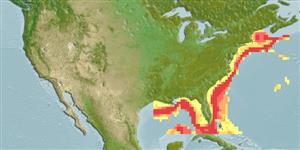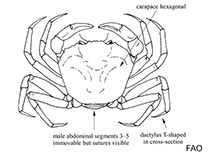Chaceon quinquedens (Smith, 1879)
Red crab| Native range | All suitable habitat | Point map | Year 2050 |

|
| This map was computer-generated and has not yet been reviewed. |
| Chaceon quinquedens AquaMaps Data sources: GBIF OBIS |
Upload your photos
Google image | No image available for this species;
drawing shows typical species in Geryonidae.
Google image | No image available for this species;
drawing shows typical species in Geryonidae.
Classification / Names Common names | Synonyms | CoL | ITIS | WoRMS
Malacostraca | Decapoda | Geryonidae
Environment: milieu / climate zone / depth range / distribution range Ecology
Benthic; depth range 0 - 2243 m (Ref. 104446). Temperate, preferred 22°C (Ref. 107945); 44°N - 23°N, 94°W - 62°W
Distribution Countries | FAO areas | Ecosystems | Occurrences | Introductions
Western Atlantic: From Emerald Bank, Nova Scotia, Canada, and the Gulf of Maine to the Mid-Atlantic Bight and the Gulf of Mexico.
Length at first maturity / Size / Weight / Age
Maturity: Lm ?, range 7 - 9.1 cm Max length : 18.0 cm CW male/unsexed; (Ref. 96186); 13.6 cm CW (female)
The larvae of this species may remain planktonic for up to 4 months before settlement depending on water temperature (Ref. 2763). Found along the continental shelf edge and slope. Associated with smooth or dimpled, unconsolidated and consolidated silt-clay sediments. Also occurs in canyon community (Ref. 96189). Displays deep-to-shallow migration as crabs mature wherein adult females generally inhabit shallower water than adult males, while juveniles tend to occur in deeper waters than adults (Ref. 96186). Reported to be opportunistic feeders. Adults eat benthic fauna such as sponges, hydroids, gastropods, scaphopods, small polychaetes and crustaceans, as well as larger prey like demersal and mid-water fish, squid and quill worm. Also scavenges deadfalls of fish and squid. May at times resort to deposit feeding and consume man-made artifacts (Ref. 96189).
Life cycle and mating behavior Maturity | Reproduction | Spawning | Eggs | Fecundity | Larvae
Adult females do not mate every year. After mating, females carry fertilized eggs on their pleopods for up to 9 months until the larvae are released (Ref. 2765). Brood sizes range from 160,000 to 270,000 eggs, and fecundity increases with female body size (Ref. 2766).
Main reference
References | Coordinator | Collaborators
Abellán, L.J.L., E. Balguerías and V. Fernández-Vergaz. 2002. (Ref. 2677)
IUCN Red List Status (Ref. 130435)
CITES status (Ref. 108899)
Not Evaluated
CMS (Ref. 116361)
Not Evaluated
Threat to humans
Human uses
Fisheries: commercial
FAO - Fisheries: landings | FishSource | Sea Around Us
Tools
More information
Internet sources
BHL | BOLD Systems | CISTI | DiscoverLife | FAO(Fisheries: ; publication : search) | Fishipedia | GenBank (genome, nucleotide) | GloBI | Gomexsi | Google Books | Google Scholar | Google | PubMed | Tree of Life | Wikipedia (Go, Search) | Zoological Record
Estimates based on models
Preferred temperature
(Ref. 115969): 3.8 - 12.9, mean 6.4 (based on 34 cells).
Nutrients: Calcium = 109 [35, 184] mg/100g; Iron = 1.59 [1.21, 1.97] mg/100g; Protein = 20.2 [19.2, 21.3] %; Omega3 = 0.285 [0.185, 0.386] g/100g; Selenium = 48.3 [-31.7, 128.3] μg/100g; VitaminA = 0 μg/100g; Zinc = 1.79 [1.17, 2.40] mg/100g (wet weight).



